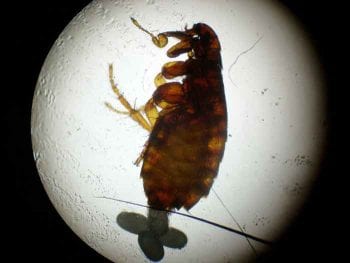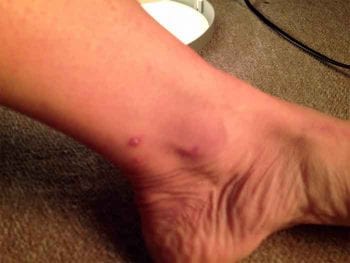1 Apr 2019
Ian Wright discusses methods vets can use to get clients on board with continuing to apply parasite treatments to their pets.

Adult cat flea and eggs.
Fleas and ticks are common ectoparasites of household pets and a source of revulsion, distress and irritation to pet owners. They can also transmit disease to both humans and pets.
Control of these parasites on pets and in households is vital, and requires consideration of pet and owner lifestyle to assess risk, and the most effective products for the individual. For control to be achieved, however, good compliance is essential, with correct dosing frequency and application. This article considers why compliance is often poor and possible steps to improve it.
Routine parasite control forms a vital part of pet health programmes, with some parasites requiring year-round preventive treatment in all pets, and others requiring a risk assessment based on geographic and lifestyle factors.
Fleas are highly prevalent on domestic cats and dogs across the UK, with 28.1% of cats and 14.4% of dogs having been demonstrated to be infested. A total of 11.3% of these flea infestations were found to be harbouring Bartonella species, which are zoonotic, and have the potential to cause chronic morbidity and be life-threatening in immune-suppressed individuals (Abdullah et al, 2019).

The only long-term measure to prevent households from exposure to Bartonella via flea faeces is adequate flea control, making correct routine use of effective adulticide products essential. Tick-borne disease also represents an ongoing and growing risk to UK dogs and their owners. This comes from both increasing numbers and activity of endemic ticks, and exotic species introduced through travelled and imported pets.
Routine tick treatment for cats and dogs – whose lifestyle puts them at risk of exposure – is a vital component of reducing tick-borne disease transmission.
Clients may approach veterinary practices for flea and tick prevention advice because of existing infestations or for routine prevention. In either case, advice should be accurately based on the latest evidence and consistently given across the whole practice team. However elegant a pet risk assessment and carefully considered preventive advice is, flea and tick control on pets will fail if compliance is poor and the product selected is not administered in the correct manner or at the correct frequency.
Clients seeking advice from veterinary practices regarding flea and tick control will want it to succeed, and yet poor compliance is a common reason for flea and tick control failures (Gates and Nolan, 2010).
Understanding the reasons for this will allow measures to be put in place to improve owner compliance. Reasons for poor compliance include a lack of life cycle understanding, difficulty administering the product, forgetting to administer the product, cost, concern over side effects, and not appreciating the value of flea and tick control. It is useful, as a practice, to consider each of these drivers of poor compliance and what steps can be taken to improve them.
The fundamental difference between pet infestations with fleas and ticks endemic in the UK is flea populations establish in homes, where ticks are mostly encountered outdoors.
Adult fleas lay eggs within 24 hours and lay 40 to 50 per day. The eggs hatch in 1 to 6 days and the larvae can pupate in as little as 10 to 20 days under warm, humid conditions. Adult fleas can then emerge from the pupae in three weeks. Under most household conditions, the life cycle can be completed in less than eight weeks. The speed of reproduction means infestation with just a few fleas can lead to heavy environmental contamination of homes and, at any one time, 95% of the flea problem exists in the home as eggs, larvae and pupae.
In the case of existing flea infestations, it is important owners understand that heavy infestations of fleas will take at least three months to eliminate, even when environmental treatment is used (Dryden et al, 2000). If this is not effectively communicated to clients, they may become disillusioned with the product used and compliance is reduced.
Emphasising the speed of flea reproduction to owners of new pets with existing flea infestations will also help them appreciate this is true, even if the new pet has been in the house for just 24 hours. Even one pet carrying a few fleas will lead to hundreds of eggs being shed into the home every day with subsequent infestation establishing.
Owners of purely indoor cats may believe flea treatment is not required if they do not understand where infestation comes from. Pupae emerge in response to movement of nearby potential hosts, their body heat and chemical emissions.
Even indoor cats may be exposed if adult emergence from pupae is triggered by pets or owners outside, leading to newly emerged adults entering households. Outdoor cats are excellent transport hosts for fleas in winter, moving adult fleas from one centrally heated home to another. Explaining this to clients will help them understand the use of a routine effective flea adulticide is crucial on cats and dogs all year round.
It is also important to emphasise, even when preventive products are used, that lifestyle may lead to re-exposure to fleas and ticks, and subsequent observation of parasites on the pet does not necessarily indicate treatment failure. Licensed isoxazoline and pyrethroid tick products are highly effective at reducing tick-borne disease transmission and eliminating ticks, but not 100% effective.

Pets at risk of tick infestation will be exposed to ticks when passing through tall grass, bracken or other undergrowth as part of their lifestyle. It is, therefore, crucial to ongoing compliance and belief in the product being used that owners understand ticks will continue to be seen on pets visiting high-tick density areas without this meaning the product is failing. Two ticks remaining on a pet represents exposure to 100 ticks if a product is 98% effective, which would not be unusual in many areas of countryside across the UK.
Explaining the flea and tick life cycles to clients, and why they are important, can be achieved through a number of different mediums. These include:
It is vital clients feel confident administering a product and in its efficacy. Preference for spot-on, collar or tablet should be discussed, and if a preference for monthly or longer-acting formulations exists. If the owner is not happy with the administration and formulation of a product, or unable to apply it, compliance and subsequent control will be lost.
Product choice is the key to improving the ease clients can administer a product with. By involving the client in the decision-making process, he or she is more likely to be happy with the mode of application and compliance will be improved. A number of points can be discussed with the client when choosing a product:
Even if all these techniques are employed, some pets will be uncooperative to the point where it is impractical or dangerous for owners to attempt to administer products. In this situation, administering products in the practice may be the only way to ensure correct application and compliance. Owners should not be made to feel like they have failed if this is the case; instead it can be an opportunity for bonding with clients and ensuring regular visits to the practice.
Reminder text and email services are useful to offer clients as a way of regularly reminding them treatments are due without the need for them to calculate or remember treatment frequencies themselves. Practice plans are useful in this regard as the correct number of treatments have already been calculated for the year and if owners are using too few or too many then this can be followed up and reminders put in place, if required.
Effective treatments can be expensive, and owners may be tempted to increase the time between treatments or purchase less effective products away from the practice.
Practice websites, social media and waiting room posters, displays and materials are opportunities to emphasise the advantages that products bought in practice bring. These may include high efficacy, a wide range of parasites treated, long duration of action and safety. These messages can also be combined with application and control advice, improving client bonding to the practice and giving a feeling of value for money.
Costs can be spread through practice plans or reduced through discounts on multiple treatments or purchases with deworming products.
Owners may have concerns regarding adverse events from personal experience of using products or from reported adverse events in the press or on social media. Some of these events may represent true adverse reactions where others may have no link to the product.
Any real or perceived event will make owners reluctant to use products and any concerns should be taken seriously. Any suspected adverse event in the practice should be reported, and the owner reassured it will be taken seriously and investigated. If concerns arise from reported cases that have occurred elsewhere, then it is important to emphasise to clients that, while adverse events can occur when any product is used, they are rare for licensed products used as indicated.
After discussion and reassurance, if owners are still doubtful about the safety of a product then an alternative should be offered. Clients are unlikely to confidently use a product they perceive may be harmful to their pet.

Pet owners who understand the purpose of preventive treatment are more likely to adhere to the instructions than those who do not. Using downloads, leaflets, online resources and social media provided by pharmaceutical companies or independent parasite advice groups, such as ESCCAP UK and Ireland, demonstrating the diseases that can be transmitted by fleas and ticks will help reinforce the reasons for preventive treatment.
Some owners will also be unaware of existing infestations. It is essential to check for fleas and ticks regularly, before initiation of parasite control and at regular intervals after a plan is in place. This establishes if current exposure is taking place, whether a flea infestation is already present and whether ongoing flea control is being effective. An exam for ticks should be performed, concentrating on the head, face, legs and ventrum (Wright et al, 2018).
The pet should also be checked for fleas using a flea comb. Fleas and flea dirt may be present. The coat should be combed or brushed on to damp cotton wool. Flea dirt will run blood red in contact with water. The presence of fleas and ticks demonstrates to owners a need for ongoing control.
The whole practice team has an essential role to play in the promotion of flea and tick control plans, and increasing compliance among pet owners implementing them. Through education of clients on the life cycles of fleas and ticks, and the risks they pose to both pets and humans, compliance can be increased.
Increased pet owner compliance and adherence to prescribed treatment protocols is essential for good preventive treatment outcomes. Providing owners with medications that are effective, cost-efficient and simple to administer, providing automated reminders and considering owner preferences in product choice will improve compliance, while also increasing clients’ bonds with their veterinary practices.
Ensuring clients are willing and able to administer routine preventive flea and tick treatments effectively, and at the correct frequency, is the foundation of all parasite control plans – and if this is not achieved, parasite control will fail.